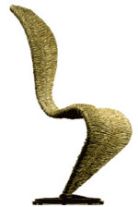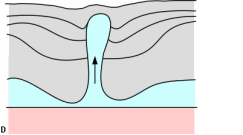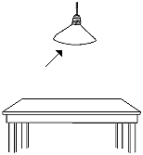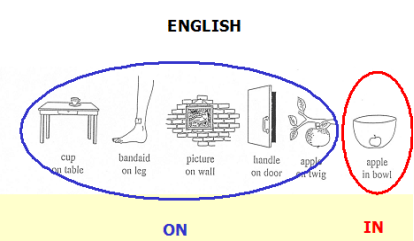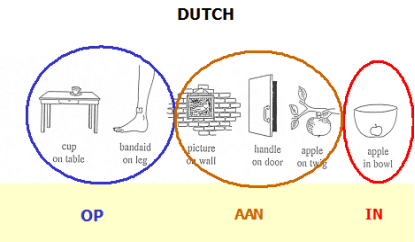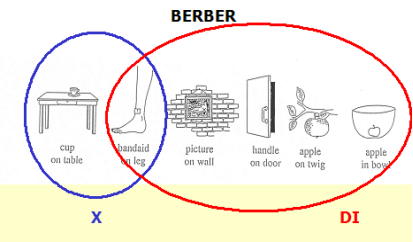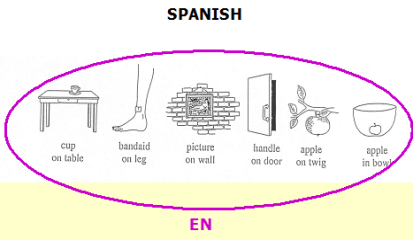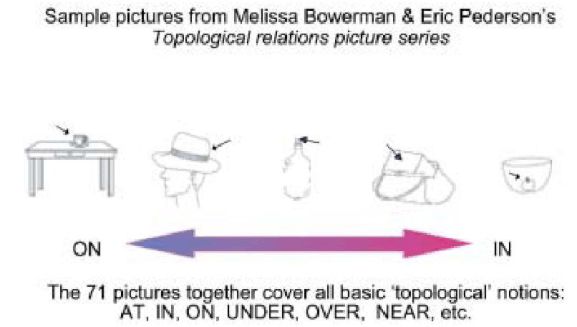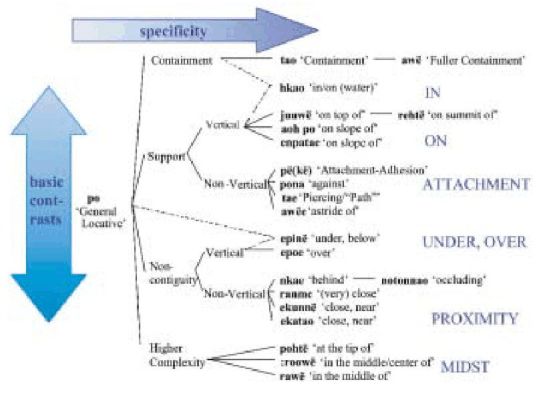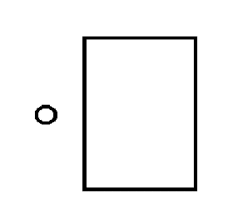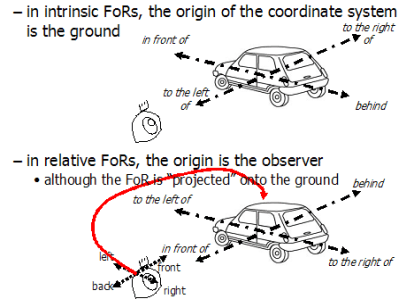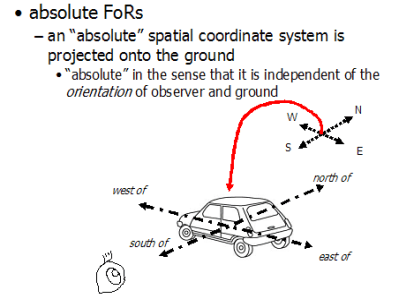Semantics - The Study of Word and Sentence Meaning
|
|
‘When I use a word,’ Humpty Dumpty said, in a rather
scornful tone, ‘it means just what I choose it to mean,
neither more nor less.’
‘The question is,’ said Alice, ‘whether you can make words
mean so many different things.’
‘The question is,’ said Humpty Dumpty, ‘which is to be
master – that’s all.’
|
Meaning is at once the most obvious and most mysterious feature of human language. We can’t
claim to know a language without knowing the meanings of words and yet more than 3,000 years
of speculation by philosophers and linguists has failed to provide a theory of meaning. In this
section we investigate whether Alice or Humpty Dumpty has a better theory of meaning. We
devise several semantic tests for different theories of meaning. We end with some examples of a
linguistic approach to the study of meaning.
Lexical and Structural Meaning
One basic distinction in semantics is the contrast between lexical meaning and sentence
meaning. We know that sentence structure makes a contribution to sentence meaning as seen in
the following examples:
The rat that bit the dog chased the cat.
The cat that chased the dog bit the rat.
These sentences are made out of the same words, but put together in different ways. The
differences tell a speaker of English what bit what and what chased what.
English speakers do not find other word orders to be equally unambiguous, e.g.,
Chased the dog the cat.
We use the combination of word meanings and sentence structure to compose the meanings of
sentences and larger units of discourse. A basic goal of linguistic semantics is to understand how
speakers construct the compositional meanings of sentences, but this goal depends on providing
a successful theory of word meaning.
Reference Theories of Word Meaning
Ask anyone about the meaning of a common noun such as chair or carburetor and chances are
they will point to an instance of such an object if it is handy. This type of ostensive definition
satisfies our intuitions about what words mean by pointing to something the word denotes, and
has prominent advocates such as John Stuart Mill. Does reference provide a valid theory of
meaning?
Referential theories of meaning define the meaning of words or phrases in terms of the things (or
actions, qualities, relations, etc.) that the word or phrase denotes. If we ask someone for a cup
and they hand us a sponge, we are apt to think they did not understand the word cup. More
precisely, we can equate the meaning of a noun with the set of things that are that object.
CUP = the set of things that are cups
SPONGE = the set of things that are sponges
Just to keep things straight, I will put a word in italics when I mention it and will use capital
letters to refer to the meaning of a word. So CUP stands for the meaning of the word cup. A cup
is the thing referred to by the English word cup.
Problem 1: Semantic Intension
A referential theory of meaning accounts for our ability to point to the things that words denote,
but it has critical shortcomings. The philosopher Gottlob Frege pointed out a critical flaw using
the phrases morning star (Phosphorus) and evening star (Hesperus). These phrases have the same
referent, but different meanings. Using them in a sentence makes this difference obvious.
The morning star is the morning star.
The morning star is the evening star.
The first of these sentences does not tell us anything new, while the second sentence does. A
referential theory of meaning does not predict this difference. Why not?
Frege distinguished between a word’s semantic extension (reference) and its semantic intension
(sense). The semantic extension of a word is the set of things the word denotes, while its
semantic intension is the concept or meaning of the word. The meaning of a word determines
the things it refers to, but it cannot be equated with its reference.
Problem 2: Words without Semantic Extension
Not all words or phrases have a semantic extension, e.g. Santa Clause, witch, phlogiston. We are
investigating whether the word meaning has a semantic extension. How do such words invalidate
reference as a theory of meaning?
Problem 3: Opaque Contexts
Sentence meaning displays a similar distinction between extensional and intensional meanings.
George is the best student in linguistics.
I dreamed that George is the best student in linguistics.
The first sentence asserts that George is one and the same shining paragon of linguistics. In other
words, it asserts that George and the best student in linguistics have the same semantic extension.
If George is the best student in linguistics then the first sentence is true. Assuming the first
sentence is true, however, does not guarantee the truth of the second sentence. The truth of the
second sentence depends on what I dreamed and not on the truth of George being the best student
in linguistics. We can usually equate the semantic extension of a sentence with its truth value, but
we see that the truth of the embedded clause has no effect on the truth value of the second
sentence. Propositional attitude verbs (dream, believe, want) create opaque contexts where the
truth value of the embedded clause is unrelated to the truth of the whole sentence. We need
something more than the reference of the embedded clause to understand meaning in opaque
contexts.
Problem 4: Referential Change
The things that words refer to seem to be changing constantly. A good example of this change is
the name of a town, e.g., Lawrence. Lawrence has been continuously expanding since its
beginning. It was burnt to the ground once and rose from its ashes. Individual buildings in the
town are constantly changing shape and color. The entity denoted by the name Lawrence is not
the same from one day to the next. A strict interpretation of a referential theory of meaning
would predict that the meanings of most names is constantly changing.
The philosopher Hilary Putnam pointed to an interesting case of semantic change in scientific
theories. One of the major advances in physics occurred when Newton equated momentum with
the product of mass and velocity. We say that Newton defined momentum as mass times
velocity. This equation held true until Einstein predicted that it would break down for objects at
relativistic speeds. Einstein redefined momentum by adding a relativistic adjustment to Newton’s
original equation. Intuitively, we feel that Newton and Einstein were talking about the same
concept, but a strict referential theory of meaning would claim that they were talking about
different things.
Problem 5: Semantic Expertise
Putnam alleges that many people cannot pick out the referents for all the words they use. He
claims that he cannot tell the difference between beech trees and elms even though he has used
the words beech and elm for most of his life. A referential theory of meaning suggests that
anyone would know the difference if they knew the words beech and elm.
Assessment
We have identified five significant problems with reference theories of meaning. These problems
supply significant information about the nature of meaning and show that meaning is something
more than reference. The text contrasts reference with sense, but never defines what sense is.
One way to think of sense is as a mode of presentation or a small story. Two phrases with the
same reference such as Barack Obama and the 44th president of the United States provide
different presentations or stories about the same referent. In cases like Hesperus and Phosphorus,
we may not know that the perspectives have the same referent. In cases like unicorns and
phoenixes, we may have perspectives without real referents. In cases like elms and lychees, we
have perspectives with vague referents.
These problems provide tests that any theory of meaning should meet. Any theory of meaning
that depends on reference will have the same limitations. We investigate some other forms of
referential theories next to see if they can respond to the five problems we discussed.
1. Mental Images
If Frege is correct then meaning is something more than reference. One idea is that meaning can
be equated with images in our mind (John Locke). While this idea has a certain appeal, it also
suffers from a number of problems.
Problem 1: Internal Reference
If we use mental images to pick out word referents we are equating meaning with mental
referents rather than external referents. To the extent that our mental images for morning star are
similar to evening star then we just have a mental image version of a referential theory of
meaning. To the extent that our mental images are different for these two concepts, we would
need to add a new component to the mental images to explain why these phrases have the same
referent.
Problem 2: Different Images
A mental image theory cannot insure that speakers of the same language carry the same mental
image for any given concept. To the extent that one speaker’s mental image of a grandmother is
different from that of another speaker, the theory cannot explain our ability to communicate via
language.
A mental image theory predicts the possibility that every speaker has their own private language.
The philosopher Wittgenstein pointed out that it would be impossible to prove that someone had
a private language to the extent that it was private.
2. Prototypes
Wittgenstein offered his own version of a mental image theory built around prototypes. The idea
is that we only require a family resemblance between objects to consider them the same.
Wittgenstein pointed out that words like game refer to many different types of contests which
lack any common features across the whole range. A game may involve multiple players or just
one. The players may play strictly for enjoyment or profit. We recognize what counts as a game
because it has one or more features of a game. Prototypical games have most of what we think of
as game features.
Problem 1: Prototype Reference
Prototype theories of meaning are based on reference to a prototype. Prototype theories encounter
all the problems that we discussed for reference theories. How would you apply Frege’s Morning
Star/Evening Star critique to a prototype theory of reference?
Problem 2: Non-prototypical Examples
Although many experiments suggest that we recognize prototypical members of a category faster
than we recognize non-prototypical members, and recall prototypical members faster as well, we
still include non-prototypical members in every semantic category. The set of dogs includes
Chihuahuas and Great Danes in addition to Labradors and retrievers. All prime numbers are
prime numbers even though 3 and 7 may be prototypical primes. Prototype theory does not
explain how we draw the boundaries between different concepts rather than just recognizing the
most typical members.
Problem 3: Prototypical Features
Prototype theories typically rely on a list of features that speakers use to define the prototype for
any concept. Prototypical features for a bird, for example, include a beak, wings, flight and
feathers. We recognize a prototypical bird to the extent that it has most of the prototypical
features. This process invites the question of how we recognize the prototypical features of birds.
They would be features that we observe on prototypical birds. We then have a circular definition
that relies on prototypical features to define the prototype, but also relies on the prototype to
define its prototypical features.
Problem 4: Combining Features
A theory of meaning has to predict how the meanings of individual words combine to produce
the meaning of a phrase. Prototype theories of meaning lack the ability to predict how to combine
the meanings of words. For example, prototypes for the word pet would include dogs and cats.
Prototypes for the word fish would include salmon and trout. But these prototypes do not predict
the prototype for the phrase pet fish.
3. Semantic Features
If mental images do not supply the critical distinctions necessary for meaning another possibility
would be that humans rely on a set of innate semantic features to construct meaning. Another
philosopher, Jerry Fodor, maintains this Language of Thought is the only explanation of our
ability to communicate ideas. The innate semantic features would be akin to a table of atomic
elements. Once we define each semantic element, we will be able to explore how they combine
to produce meaning. Needless to say, the theory of innate semantic features also runs into
difficulties.
Problem 1: Feature Reference
Semantic Feature theories must explain how speakers fix the reference of each feature. Lyons
(1973) pointed out that semantic features never seem to provide enough power to explain word
meaning. A theory that tells us the meaning of mare has the feature ANIMAL won’t take us very
far if the theory doesn’t supply a meaning for ANIMAL. If the feature theory uses reference to fix
the meaning for ANIMAL, it is just another type of reference theory with an intermediate mental
vocabulary. We might assume, with Fodor, that ANIMAL refers to a mental concept or brain
state. Does this version of feature theory evade Frege’s problem?
Problem 2: Feature Arbitrariness
Semantic feature theories have been criticized for their arbitrary nature (Burling, American
Anthropologist 1964 ‘God’s truth or hocus pocus?’). Does the meaning of the word man contain
a semantic feature [+MALE] or the feature [-FEMALE]. Either feature would allow you to
distinguish the meanings of the words man and woman, but there is no reason to prefer [+MALE]
over [-FEMALE].
Mathematicians have devised various definitions for the concept NUMBER. Dedikine proposed
a ‘cut’ in the number line, while Russell & White proposed a definition using set theory. Both
definitions are equally valid, but we have no reason to prefer one over the other.
Usage Based Theories of Meaning
We investigated several types of reference based theories of meaning of the sort Alice would
approve and found that they all face difficulties discussed by Frege. Frege offered a Humpty
Dumpty theory of meaning as an alternative. A usage based theory of meaning equates meaning
with the ways that words are used. Dictionaries commonly employ a usage based approach in
their definitions of word meaning. Linguists and philosophers sneer at dictionary type definitions,
but they have yet to offer a viable alternative. Linguists have much to learn from exploring the
practical approach that lexicographers use to construct definitions. We will explore the criticisms
of dictionary definitions in the text book before looking at how a usage based theory meets the
five tests we used for reference based theories.
Problem 1: Dictionary Definitions Use Words in Definitions for Other Words
A common complaint about dictionary definitions is that you have to know the meanings of the
words the dictionary uses before you can understand the meaning of the word you are looking up.
The American Heritage College Dictionary provides the following definitions:
opossum
1. Any of various nocturnal, usually arboreal marsupials of the family Didelphidae, ... of the
Western Hemisphere, having a thick coat of hair, a long snout, and a long prehensile tail.
2. Any of several similar marsupials of Australia belonging to the family Phalangeridae.
diapir
An anticlinal fold in which a mobile core, such as gypsum, has pierced through the more brittle
overlaying rock.
The philosopher Willard Van Orman Quine proposed a dictionary type theory of meaning as a
basis for his thesis of semantic holism. Semantic holism assumes that the meaning of every
word depends on the meanings of other words, tying word meanings into a semantic net. The
more we learn about the whole, the more we know about the meaning of each word. A change in
our understanding of a word will affect our understanding of the whole. Quine’s semantic theory
reflects his view of science where a single discovery can radically transform our understanding of
everything.
A usage based theory provides a dynamic theory of meaning. It recognizes that we do not know
everything (a state Putnam labels logical omniscience). We need to discover that Phosphoros
and Hesperus refer to the same planet. A usage based theory explains why we can use words such
as elm or beech the way other people use them without being able to identify their exact
referents. A usage based theory ties meaning to a linguistic community rather than to the mind of
individual speakers.
Problem 2: Dictionary Definitions Include Function Words
Dictionary definitions cannot avoid using common function words such as the, of or to in their
definitions. This practice seems to create a problem of accounting for our understanding of these
words. Function words actually provide strong evidence in support of usage based theories since
these words lack obvious referents and differ considerably in use from language to language.
Some languages lack articles or prepositions altogether. Quine observed that the meaning of
articles like the depends on whether languages also have plural markers or noun classifiers.
Truth Conditions and Possible Worlds
For many sentences we can tell what the world would be like if the sentences were true. We
know that an ordinary situation in which a glass is half full is identical to the situation in which
the glass is half empty. The sentences ‘The glass is half full’ and ‘The glass is half empty’ have
the same truth conditions, and so have the same meaning. A theory that can account for the
conditions under which a sentence is true could capture a great deal about the meaning of the
sentence.
Once we investigate the truth conditions for sentences, we soon discover that the truth conditions
for some sentences are anything but straight forward. Counterfactual sentences (e.g., ‘If time
travel was possible, I’d visit my great, great grandmother.’) construct truth conditions that can
only be evaluated in some imaginary scenario–not the real world! The possible worlds of
counterfactual semantics are different from the parallel universes of science fiction in that the
possible world created by a counterfactual sentence is as close to reality as possible given a
single change. Making this similarity precise enough to evaluate the truth of a counterfactual
sentence creates a challenge.
Another challenge for a theory of meaning based on truth conditions is to provide for sentences
which fail to meet the necessary conditions for having a truth value. These conditions are known
as presuppositions in the semantics literature. Russell’s famous example of such a sentence was
‘The present king of France is bald.’ Since there is no king of France at present, we can not
assign a truth value to the sentence.
There are also a great many sentences whose meaning is largely determined by their situations of
use rather than their truth conditions. Any question, e.g., ‘Why did the chicken cross the road?’
lacks a direct connection to a set of truth conditions. One possibility is to evaluate the truth
conditions of questions in terms of the truth conditions of the answers to the question. Another
possibility is to evaluate the meaning of questions and commands in terms of their situations of
use. We ask someone ‘Can you pass the salt?’ not out of concern about their recent medical
history, but to obtain the salt. Even though the sentences ‘The glass is half full’ and ‘The glass is
half empty’ have the same truth conditions, they have very different situations of use.
Lexical Sense
Semantic relations provide valuable clues to meanings or senses of words. Rather than trying to
define of the meaning of a word in isolation, you can analyze how the meaning of a word
contrasts with the meaning of another word. Antonyms provide a familiar example of a sense
relation. There are different types of antonymic relations.
Complementaries divide the world into two categories, e.g., open/shut, dead/alive, true/false.
We see that complementaries are not acceptable in certain sentences:
1 a. # The door is neither open nor closed.
b. # He shot at the target and he neither hit it or missed it.
c. # The dog is neither dead nor alive.
Non-complementary words allow for intermediate categories
Non-complementary words form acceptable sentences with neither:
2 a The water is neither hot nor cold.
b. The performance was neither good nor bad.
c. He is neither short or tall.
Horn (2001:270) diagrams the difference between complementaries and non-complementaries as:
|
|
|
Non-complementary Opposition
|
|
|
|
|
|
not-F
|
|
Complementary Opposition
|
|
not-G
|
|
|
F
|
G
|
|
F
|
not F and not G
|
G
|
|
black
|
nonblack
|
|
black
|
|
white
|
|
odd
|
even
|
|
bad
|
|
good
|
|
male
|
female
|
|
sad
|
|
happy
|
|
Horn (271) observes:
In his seminal investigation of gradable terms, Sapir (1944:133) points to the existence of a
‘psychological excluded middle’: ‘Three-term sets [superior/average/inferior,
good/moderate/bad, big/medium/small, warm/lukewarm/cool] do not easily maintain themselves
because psychology, with its tendency to simple contrast, contradicts exact knowledge, with its
insistence on the norm, the “neither nor”’. It is because of this psychological preference for
simple, either-or contrast that the ‘normed’ or middle term, occupying a ZONE OF INDIFFERENCE,
tends to be ‘quasi-scientific rather than popular in character’ and that it is itself typically
ungradable (?more average, ?more lukewarm). Nor is it an accident–as Sapir and Aristotle have
both noted–that the zone of indifference must often be characterized negatively, as ‘neither X nor
Y’.
Other important semantic relations include:
|
synonyms
|
words with the same meaning
|
sofa::couch, insect::bug
|
|
hyponyms
|
words in a kind relation
|
woman::animal, rose::plant
|
|
meronyms
|
words in a part/whole relation
|
finger::hand, leg::table
|
A semantic theory should provide an explanation for all of these types of semantic relations.
A Compositional Theory of Meaning
Below is an example of a simple semantic framework to give you an idea of what a
compositional approach would look like. These example use semantic extensions rather than
semantic intensions. What other shortcomings can you find in this theory?
The Lexicon
|
Midge
|
SVal(Midge)
|
=
|
Midge
|
|
Keeper
|
SVal(Keeper)
|
=
|
Keeper
|
|
barks
|
SVal(barks)
|
=
|
the set of creatures that bark
|
|
grins
|
SVal(grins)
|
=
|
the set of creatures that grin
|
The Syntax
|
NP
|
—>
|
name
|
|
VP
|
—>
|
IV
|
|
S
|
—>
|
NP + VP
|
|
name
|
—>
|
Midge, Keeper
|
|
IV
|
—>
|
barks, grins
|
The semantic valuation (SVal) for the sentence (its interpretation) is given by checking to see if
the named creature is a member of the set specified by the verb, i.e.:
SVal(S) = true iff SVal(NP) ∈ SVal(VP)
The syntax produces a sentence such as:
Keeper barks
We can interpret this sentence by applying the following rule:
SVal(Keeper barks) = true iff SVal(Keeper) ∈ SVal(barks)
This statement is just a formal way of stating the ordinary sentence:
Keeper barks is true if and only if Keeper is a member of the set of things that bark.
|
Things that grin
Midge Buddy
|
|
Things that bark
Keeper Happy
|
How would you add the word and to the lexicon?
Linguistic Semantics
It is possible to use linguistic methods to investigate semantics rather than philosophical
arguments. The primary method linguists can deploy is to describe the semantic distinctions
speakers use their words to make akin to the phonemic distinctions that speakers observe. One
early paper that illustrates the linguistic approach is Labov’s study of cups (‘The Boundaries of
Words and Their Meanings’, in R. Fasold, ed. 1973). Labov explored the semantic boundaries of
the words cup, mug, bowl and vase. He provided subjects with line drawings of containers that
varied in width and height.
He also presented the drawings to his subjects in two contexts. In the first, or ‘neutral’ context,
he merely presented the drawings. In the second, or ‘food’ context he presented the drawings and
said they contained rice or mashed potatoes.
Space
The expression of spatial location would appear to be one of the most fundamental semantic
notions common to all humans. After all, we seem to have a good idea of where we are most of
the time. Spatial language turns out to be anything but a simple reflection of an objective reality.
Recent cross-linguistic research has revealed a surprising degree of variation exists in spatial
expressions between languages.
Languages locate objects in relation to some reference point. Herskovits (1986) refers to the
located entity as the located object. She calls the noun phrase that specifies the location the
reference object. Talmy (1983) refers to these notions as figure and ground, respectively.
Spatial locations are essentially relations between the located object and a reference object:
1. The cup is on the table.
Located Reference
Object Object
Figure Ground
|
|
Talmy ([1983] 2000: 184) figure and ground as:
“The Figure is a moving or conceptually movable entity whose site, path, or orientation is
conceived as a variable the particular value of which is the relevant issue.”
“The Ground is a reference entity, one that has a stationary setting relative to a reference frame,
which respect to which the Figure’s site, path, or orientation is characterized.”
Talmy introduces the notion of relevance into his definition of figure since the speaker’s
perspective determines what is picked out at the figure. In many cases, either object in a spatial
relation can be picked out as the figure:
2a. The lamp is over the table.
b. The table is under the lamp.
|
|
A similar relation holds for deictic statements. The deictic phrase in (3) points to a located object
relative to a reference object – the speaker. Deixis as well as spatial location have the same
relational foundation.
3. That cat
Talmy (2000: Vol. I p. 183) hypotheses the following features determine which objects speakers
select as the figure and ground:
Figure
|
Ground
|
has unknown spatial (…) properties to be
determined
|
acts as a reference entity, having known
properties
that can characterize the [figure’s] unknowns
|
more movable
|
more permanently located
|
smaller
|
larger
|
geometrically simpler (often point like) in its
treatment
|
geometrically more complex in its treatment
|
more recently on the scene/in awareness
|
earlier on the scene/in memory
|
of greater concern/relevance
|
of lesser concern/relevance
|
more salient, once perceived
|
more backgrounded, once [figure] is
perceived
|
more dependent
|
more independent
|
7.1 The Geometry of Linguistic Space
We learn to think about space in school as a three-dimensional Euclidean projection. In
Euclidean space, parallel lines never meet. We may also know about Riemannian geometries in
which parallel lines meet or grow farther apart, but these geometries do not seem to apply to the
everyday world.
Although spatial concepts appear to be stable and universal, a closer look at the language we use
to express spatial relations reveals the degree to which speakers impose spatial relations on the
perceived world. Consider the following sentence:
4. The lamp is in the corner of the room.
Hearing this sentence, we would not expect the lamp to be plastered into the corner. Instead we
use our knowledge of lamps to construct a scene in which the lamp may be standing in the
vicinity of the corner.
In the sentence:
5. I have a pen in my hand.
the pen is only partly inside the contour of the hand. The sentence does not specify whether the
hand is open or closed, but we assume the pen is in contact with the palm rather than resting on
the opposite side of the hand.
To the degree we use our knowledge of the properties of located objects and reference objects,
we linguistically warp space to express spatial relations.
7.2 Topological Locations
Topological locations are invariant with respect to changes in the reference object. The three
basic topological locations are proximity, containment, and exteriority. They are topological
because they remain the same no matter what angle the located object is viewed from.
Proximity refers to the near or total spatial overlap of the located object and the reference object.
Consider the following expressions of proximity:
6a. The fly is on the wall.
b. Harry is at the fence.
No matter how the fly or Harry is viewed, their relation of proximity to the reference object
remains the same. The fly in (5a) is actually in contact with the wall, while Harry need only be
standing near the fence in (5b). The distance between the located and reference objects in
expressions of proximity depends on the properties of the objects. Speakers use their knowledge
of the located objects and reference objects to calculate the distance needed to express proximity.
The expression of proximity uses a conceptually constructed space.
The preposition on requires contact between the located and reference objects in addition to the
other properties. The contact does not have to be direct – merely supportive in an extended sense.
In the sentence:
9. The apple is on the table.
The apple does not have to be in contact with the table. It could be resting on a table cloth or
stack of books. The nature of the contact expressed by on depends on the dimensionality of the
reference object, as seen in the following examples:
10a. The clothes are on the clothesline.
b. The picture is on the wall.
One-dimensional objects such as clotheslines or fishing lines can provide support from above,
while two-dimensional objects such as walls or paper can provide support from the side. For one-, two- and three-dimensional objects, on is associated with contact between the located object
and the surface of the reference object.
7.2.2 Containment
Containment denotes the inclusion of a located object in the reference object. Containment may
be: i. either partial or total, ii. apply in any dimension, and iii. be either real or virtual:
11a. The books are in the box.
b. There’s a crease in the bedspread.
c. What do you have in mind?
The books may be completely or only partially contained by the box. The box may also be
opened on its top, or on its side. What matters is whether the books are in contact with the box’s
interior in some fashion. The dimensional properties of the reference object are shown in (11b).
Two-dimensional objects such as paper and blankets have interiors within their boundaries. Their
interiors are simultaneously potential supports. The located object must be part of the two-dimensional reference object for containment to supercede support (Herskovits 1986):
12a. ?? The check mark is in the page.
b. The check mark is in the margin.
What counts as an inherent part of a located object is not obvious:
13a. There is a blemish on your skin.
b. I found a scratch on my car.
The mind in (11c) is treated as a metaphorical container with the potential to contain ideas and
more. The goddess Athena supposedly sprang from the mind of Zeus.
7.2.3 Exteriority
Exteriority refers to the relation in which the located object is external or outside of the
reference object. Exteriority is a topological relation because the viewer’s perspective does not
affect the relation. Exteriority applies regardless of whether the located object is completely or
partially outside the reference object:
14a. The ball is out of the box.
b. Bill is outside the room.
The dimensionality of the reference object also affects the application of exteriority. The
reference object must have an interior for the located object to be exterior to:
15a. ?? The clothes are outside the clothesline.
b. ?? Jane stepped out of the spot.
Although away also appears to mark exteriority, this effect is entailed by its use to indicate non-proximity. Consider the sentence:
16. Mark is away from his home.
If Mark is not close to home then he must be somewhere outside the home. Away can be
analyzed as the negation of proximity.
7.3 Cross-linguistic Encoding of Topological Relations
Melissa Bowerman pioneered the cross-linguistic study of topological encoding. She initially
looked at the encoding of in and on in English, Dutch, Spanish and Berber.
In a recent article (Language 79:485-516), Steve Levinson and his coworkers examine the
topological relations of proximity and containment in a sample of nine languages.
LANGUAGE AFFILIATION LOCATION DEMOGRAPHY CONSULTANTS RESEARCHER
Basque Isolate Europe 660,000 26 I. Ibarretxe
Dutch Indo-European Europe 20,000,000 10 D. Wilkins,C. de Witte
Ewe Niger-Congo West Africa 3,000,000 5 F. Ameka
Lao Tai-Kadai Southeast Asia 3,000,000 3 N. Enfield
Lavukaleve Isolate Solomon Islands 1,150 1 A. Terrill
Tiriyó Cariban South America 2,000 10 S. Meira
Trumai Isolate South America 50 3 R. Guirardello
Yélý̂ Dnye Isolate Papua New Guinea 3,750 4 S. Levinson
Yukatek Mayan Mesoamerica 700,000 5 J. Bohnemeyer, C. Stolz
They used Bowerman’s set of pictures to elicit spatial relations from speakers of these languages.
Each picture contains a line drawing with the located object shown in yellow. The speakers were
asked questions of the form Where is the [located object]? An example of their stimuli is shown
below.
They report that the languages show considerable diversity in the range of lexical devices for
encoding spatial relations. English relies primarily on prepositions, but some languages (e.g.,
Basque, Trumai) use relational nouns instead. English uses the relational nouns side and top in
combination with prepositions to express spatial relations, e.g., inside, outside, on top. Still other
languages (e.g., Dutch, Ewe, Yélî Dnye) use positional verbs similar to the English verbs sit,
stand, lie, etc. The number of spatial adpositions found in the language sample varied between 2
for Yukatek and Lao, 50+ for Dutch and Yélî Dnye, and 100+ for Tiriyó. The languages with
large numbers of spatial adpositions organized them into hierarchical relations. Levinson et al.
provide the following ‘map’ for the adpositions in Tiriyó.
Levinson et al. tested the hypothesis that all languages apply their basic adpositions for in, on,
under and near to the same core set of topological relations. This hypothesis is derived from the
idea that spatial relations are universal since they directly encode basic elements of
neurocognition (Pinker 1994). Levinson and coworkers tested the hypothesis by laying out their
stimuli in a two-dimensional grid and tracking the extensional set for the adpositions in each
language.
7.5 Functional Relations
I. Nyoman Aryawibawa (2008) explored the semantics of spatial relations in Rongga, Balinese,
and Indonesian. These languages employ unmarked prepositions to express normal relations
between objects and marked prepositions to express abnormal relations.
Rongga>
|
Kain meja one meja
|
Li’e munde one mok
|
|
cloth table on table
|
that orange in bowl
|
|
‘The table cloth is on the table’
|
‘The orange is in the bowl’
|
Changing to an abnormal relation between the figure and ground results in the use of a marked
preposition. The marked form is used if the table cloth is folded and then put back on the table or
if a ribbon is put in the bowl instead of an orange.
|
Kain meja zheta wewo meja
|
Pita zhale one mok
|
|
cloth table on table
|
ribbon in bowl
|
|
‘The table cloth is on the table’
|
‘The ribbon is in the bowl’
|
Aryawibawa contrasts Levinson et al’s topological categories with those of Rongga, Balinese,
and Indonesian:
|

|

|

|

|
Levinson et al:
|
attachment
|
superadjacency
|
full containment
|
subadjacency
|
|



|

|
Aryawibawa:
|
function
|
location
|
7.4 Projective Locations
Projective locations depend upon the viewer’s perspective or properties of the reference object. A
ball could be in front of a desk from one perspective, beside the desk from another, and behind
the desk from a third perspective.
Some objects have conventional features that speakers treat as fronts or backs. The back of a
chair provides back support. The front of a house is marked by the main entry way. Objects may
be located in relation to the fronts, backs or sides of reference objects. Speakers must decide
whether to use their own perspective or the features of reference objects to encode projective
locations.
7.4.1 Front<
The ‘front’ of an object depends on properties of the reference object and/or the perspective of
the viewer. Languages chose different vantage points to determine a viewer’s perspective.
English uses the side of the reference object facing the viewer as the ‘front’. Hausa uses the
opposite side of the reference object, the side facing away from the viewer as the ‘front’ (Hill
1974, 1982). In the situation shown below, an English speaker would say the spoon is in front of
the pumpkin. A Hausa speaker would say (Hill 1982:21):
16. Ga cokali can baya da k’warya.
look spoon there back with pumpkin
‘There’s the spoon behind the pumpkin’
|
Viewer’s
————>
Perspective
|
|
|
There is more variation between languages in the attribution of ‘front’ and ‘back’ to inanimate
objects. The front of vehicles is the part facing the forward motion. Even though ships have bows
rather than fronts, we can still locate an object in front of a ship. The fronts of chairs and houses
are determined by the convention point of access. This convention applies to appliances such as
tvs and radios whose access point – the ‘on’ button, defines the front.
Other languages impose an anthropomorphic image on inanimate objects to a much greater
extent. Languages that make use of relational nouns rather than adpositions are especially prone
to attribute fronts to things. The Mayan language K’iche’ uses a single preposition in
combination with a set of relational nouns to express spatial location (Kaufman 1990:77):
|
Prep.
|
Rel. Noun
|
English Equivalent
|
|
chi +
‘at, on’
|
xee’ ‘root’
chii’ ‘mouth’
wi’ ‘head’, ‘hair’
iij ‘back’
wach ‘face’
|
‘below’, ‘beneath’
‘next to’
‘above’, ‘on top of’
‘behind’, ‘outside’
‘in front of’
|
K’iche’ and English speakers agree on the features for many objects. Both would define the
‘front’ (English)/‘face’ (K’iche’) by reference to the front door (u:-chii’ jah ‘its-mouth house’ in
K’iche’). Both would agree on a located object being ‘beneath’(English)/‘root’ (K’iche’) a chair
or table. But, K’iche’ speakers extend their relational nouns in ways that English speakers cannot
predict. Rather than saying something is ‘on’ the ground, K’iche’ speakers say it is on the face of
the ground (chi+u:-wach uleu). Rather than saying something is on top of a house, K’iche’
speakers say it is on the back of the house (chi+r-iij lee jah).
Other projected locations include back/behind, below, above, and left/right.
7.5 Absolutive Systems
Levinson (1996) describes two other types of frames of reference: intrinsic and absolutive.
Language like English use a relative system of spatial reckoning for projected locations. A
relative system is based on the speaker’s or hearer’s perspective or the features of the reference
object. These projections may be either relative or intrinsic.
Levinson (1996) provides evidence that speakers of other languages employ an absolutive system
of spatial reckoning. An absolutive system is based on a fixed set of spatial coordinates, eg.,
north, south.
Tzeltal Mayan has an Absolutive system of spatial reckoning based on the predominant
uphill/downhill lay of the land (along a South (uphill)-North (downhill) axis):
|
|
Verb
|
Position
|
Relation
|
|
UP
DOWN
|
mo ‘ascend’
ko ‘descend’
|
kaj ‘be above’
pek’ ‘be low down’
|
ajk’ol ‘uphill’
alan ‘downhill’
|
e.g., ‘The rain is descending’ (i.e., coming from the south)
‘It (a puzzle piece) goes in downhillwards’
Tzeltal children begin to use the Absolute vocabulary in the one- and two-word stage to refer to
vertical relations (with verbs of falling and climbing) as well as horizontal relations (movement
between houses or of toy cars on the flat patio) (Brown 2001).
The core semantics for the children’s verbs mo/ko are restricted at first to local places (particular
houses in the local compound). The children generalize these verbs to novel contexts such as
moving objects into trees, onto beds, up onto the roof, and to and from particular houses.
Marquesan, a language of French Polynesia, has speakers that live almost exclusively on islands.
As a seafaring people, the Marquesan speakers use the directionals “Seaward,” “inland,” and
“Across” (or to:place name). The interesting distinction between this spatial reference system
and that of Tzeltal is the while in Tzeltal “Uphill” will always denote one direction, “seaward,”
though still an absolute spatial reference (as the sea isn’t going anywhere), can mean a different
direction based on where you are on the island. The semantic implications of this are fascinating,
in that a speaker must constantly know exactly where they are with respect to the ocean in order
to have any frame of reference for where anything else is. Marquesan speakers use this system in
both large scale and small scale directional referencing.
“For a speaker of Marquesan it is not unusual to say that the plate on the table is inland of the
glass or to localize a crumb on another person’s cheek as being on the seaward or inland cheek.”
(Cablitz p.41)
References>
Aryawibawa, I Nyoman. 2008. Semantic Typology: Semantics of Locative Relations in Rongga
(ISO 639-3: ROR). Masters Thesis. University of Kansas
Bowerman, Melissa. 1999. Learning How to Structure Space for Language: A Crosslinguistic
Perspective. In P. Bloom, M. A. Peterson, L. Nadel and M. F. Garrett (eds.), Language
and Space, 385-436. Cambridge, MA: MIT Press.
Brown, Penelope. 1994. The INs and ONs of Tzeltal locative expressions: The semantics of
stative descriptions of location. Linguistics 32.4/5.743-790.
Brown, Penelope. 2001. Learning to talk about motion UP and DOWN in Tzeltal: is there a
language-specific bias for verb learning? In M. Bowerman and S. C. Levinson (Eds.),
Language Acquisition and Conceptual Development, 512-543. Cambridge: Cambridge
University Press.
Cablitz, Gabriele H. 2002. The acquisition of an absolute system: learning to talk about SPACE
in Marquesan (Oceanic, French Polynesia). The Proceedings of the 31st Stanford Child
Language Research Forum, pp. 40-49.
Dopkins, Stephen & Gleason, Theresa. 1997. Comparing exemplar and prototype models of
categorization. Canadian Journal of Experimental Psychology 51(3).212-230.
Frawley, William. 1992. Linguistic Semantics. Hillsdale, NJ: Erlbaum.
Fodor, Jerry A. 1975. The Language of Thought. Cambridge, MA: Harvard University Press.
Herskovits, Annette. 1986. Language and Spatial Cognition. Cambridge: Cambridge University
Press.
Hill, Clifford. 1974. Spatial perception and linguistic encoding: A case study of Hausa and
English. Studies in African Linguistics (Supplement) 5.135-148.
Hill, Clifford. 1982. Up/Down, front/back, left/right. A contrastive study of Hausa and English. In J. Weissenborn and W. Klein (Eds.), Here and There, 13-42. Amsterdam: Benjamins.
Kamp, Hans & Partee, Barbara. 1995. Prototype theory and compositionality. Cognition
57(2).129-191.
Kripke, Saul A. 1980. Naming and Necessity. Cambridge, MA: Harvard University Press.
Levinson, Stephen C. 1996. Frames of Reference and Molyneux’s Question: Crosslinguistic
Evidence. In P. Bloom, M. A. Peterson, L. Nadel and M. F. Garrett (eds.), Language and
Space, 109-170. Cambridge, MA: MIT Press.
Levinson, Stephen, Sérgio Meira, and The Language and Cognition Group. 2003. ‘Natural
concepts’ in the spatial topological domain—adpositional meanings in crosslinguistic
perspective: An exercise in semantic topology. Language 49.485-516. Burling, Robbins.
1964. Cognition and componential analysis: God's truth or hocus-pocus?
American Anthropologist 66.20-28.
Putnam, Hilary. 1988. Representation and Reality. Cambridge, MA: MIT Press.
Quine, Willard Van Orman. 1960. Word & Object. Cambridge, MA: MIT Press.
Wierzbicka, Anna. 1980. Lingua Mentalis: The Semantics of Natural Language. Sydney:
Academic Press.

